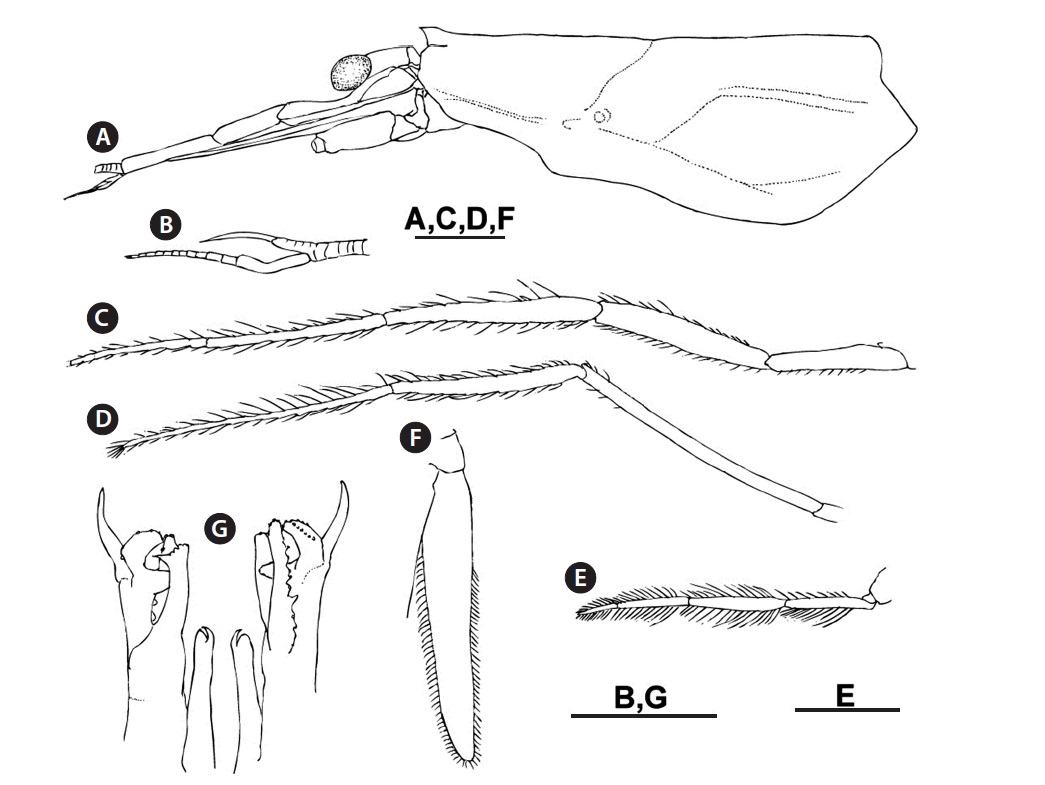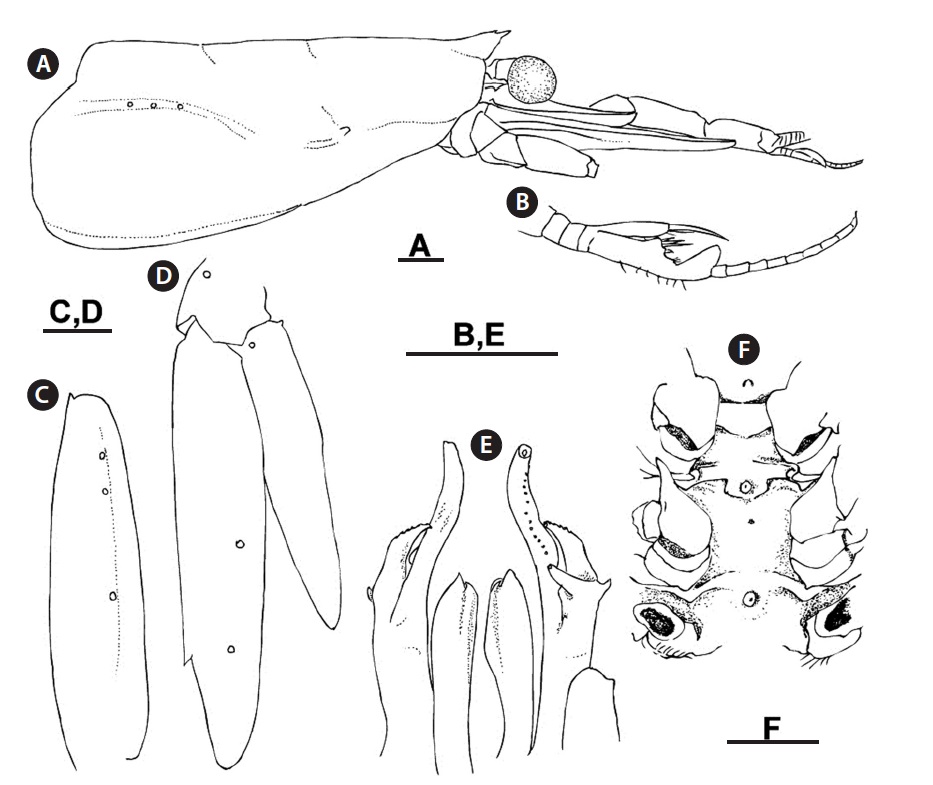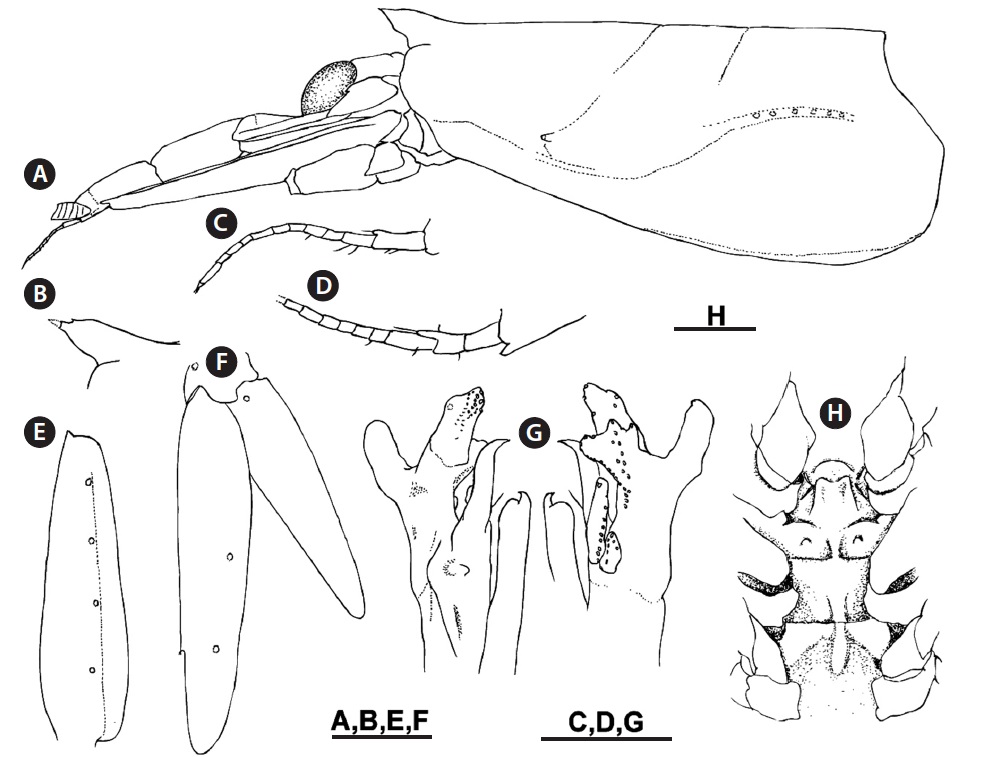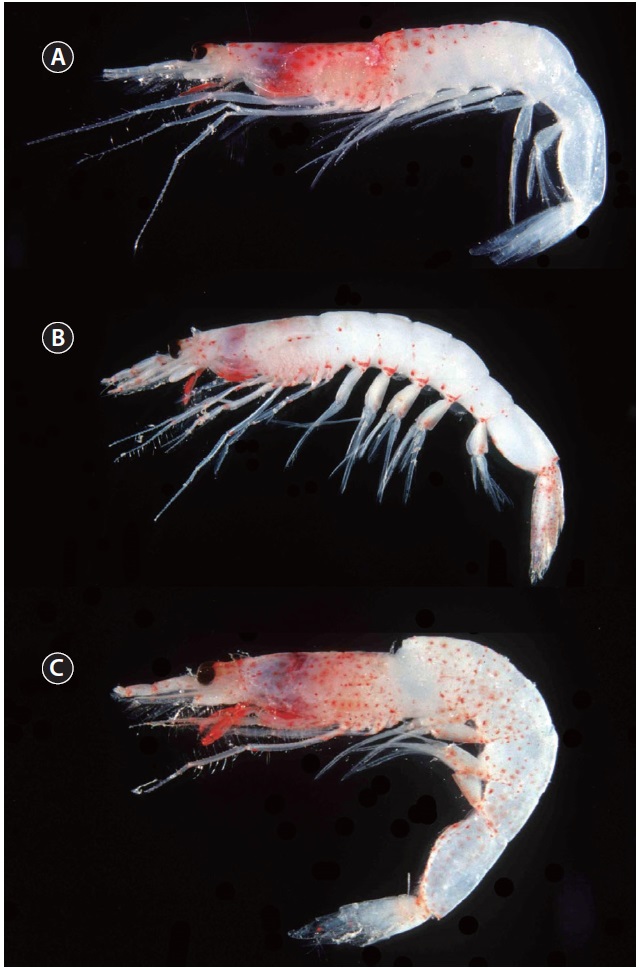



Three species of pelagic sergestid shrimps, Deosergestes seminudus (Hansen, 1919), Sergia lucens (Hansen, 1922) and S. talismani (Barnard, 1947), were identified based on collections by the National Fisheries Research and Development Institute from the Korean coast of the Yellow Sea between 2003 and 2011. They are herein reported for the first time from the Yellow Sea. Morphological descriptions and illustrations with color photographs of all species are also given. With the addition of these species, the family Sergestidae in the Korean waters now comprises five species belonging to three genera. Finally, a key to the Korean genus and species of the family Sergestidae is presented.
The family Sergestidae, which is mostly of the pelagic form, comprises 98 species and two subspecies belonging to 11 genera worldwide (De Grave and Fransen, 2011). Their great abundance in the water column plays an important role in the food chain of the oceans, and they are a very commercially important organism in Asian and East African waters (Holthuis, 1980; Hayashi, 1992). However, only two species of Korean sergestid shrimps have been known:
During a series of research cruises in Korean waters, three species belonging to the family Sergestidae, namely
Shrimp specimens were collected during a series of expeditions to investigate fisheries resources in the Korean Exclusive Economic Zone (EEZ in 2003- 2011) using the R/V Tamgu 1 and Tamgu 20 of the National Fisheries Research and Development Institute (NFRDI). Bottom otter trawls (mesh size at the cod end 0.98 × 0.98 mm) were used to collect shrimp specimens. Trawls with otter boards were towed for 30 to 60 min at approximately 3.4 knots. All samples were frozen on board shortly after capture and maintained at ?80℃ until laboratory identification. Before species identification, the specimens were photographed and then preserved with 70-90% ethanol. The specimens were deposited in the Fisheries Resource Management Division, NFRDI.
The carapace length (CL), measured from the postorbital margin to the posterior mid-dorsal margin of the carapace, was used to indicate the size of the specimens. The terminology used in this study primarily followes that of Vereshchaka (2000). Genera and species are arranged in alphabetical order.
Family Sergestidae
Genus
(new Korean name:
(new Korean name:
Southern part of the Yellow Sea: Western water of Hong Island, 34°40.4´N, 123°20.2´E, 77 m, otter trawl, R/V Tamgu 1, Mar 21, 2003, one male (CL 10.6 mm).
Body slender, compressed. Rostrum (Fig. 1A) small, somewhat produced forward, with pointed apex. Carapace (Fig. 1A) with hepatic spine, small but distinct; cervical groove deep; rounded branchiocardiac carina well marked, rounded hepatic-antennal carina present. Abdomen smooth. Telson tapering to subacute apex, lacking spines. Eyes (Fig. 1A) slender, elongate cornea slightly broader than eyestalk. Antennular peduncle (Fig. 1A) slender and long; third segment longer than second; in male, ventral flagellum (Fig. 1B) bifurcated, like clasping organ. Antennal scale (Fig. 1A) reaching middle of third antennular segment; distolateral tooth very small. Third maxilliped (Fig. 1C) over-reaching distal margin of antennal scale by distal two segments: distal segment subdivided into eight articles. Third pereopod (Fig. 1D) over-reaching distal margin of antennal scale by distal two segments. Fifth pereopod (Fig. 1E) with two distal segments setose on both ventral and dorsal margins. Exopod of uropod (Fig. 1F) setose on distal 0.6 of its lateral margin, without lateral tooth. Petasma (Fig. 1G) with processus uncifer somewhat slender, hooked at tip; processus ventralis distally expanded to form broad terminal
edge furnished with row of many acute papillae; lobus armatus straightly elongated, reaching distal margin of processus ventralis: distal margin armed with row of several hooks, with large anterior hook laterally; lobus connectens somewhat small, oblong triangular, directed outward with about eight hooks on distal half; lobus terminalis moderately short, with obliquely rounded tip, curving outward, distal surface scattered with many small hooks; lobus inermis considerably longer than lobus terminalis, directed forward and somewhat inward, tapering to narrow subacute tip without hooks.
Body generally semitransparent, with many red spots of stellate chromatophores on dorsoanterior part (Fig. 4A).
Indo-West Pacific: Korea, Japan, Taiwan, Indonesia, India; meso- and bathypelagic. In Korea, only southern water of western coast in this study.
Judkins and Kensley (2008) separated five new genera from
Genus
(new Korean name: Kkoch-jeot-sae-u-sok)
(new Korean name: Kkoch-jeot-sae-u) (Figs. 2, 4B)
Southern part of the Yellow Sea: Western water of Jeju Island, 33°00.0´N, 124°38.7´E, 72 m, otter trawl, R/V Tamgu 1, Mar 26, 2003, two males (CL 7.1, 10.3 mm); Southwestern
water of Jeju Island, 32°41.8´N, 125°15.9´E, 72 m, otter trawl, R/V Tamgu 1, Oct 28, 2004, two males (CL 9.3, 9.5 mm); Southern water of Gageo Island, 33°45.5´N, 125°14.6´E, 94 m, otter trawl, R/V Tamgu 1, Apr 19, 2008, one female (CL 11.0 mm); Southeastern water of Gageo Island, 33°39.9´N, 125°44.8´E, 100 m, otter trawl, R/V Tamgu 1, Apr 19, 2008, one female (CL 11.1 mm).
Rostrum (Fig. 2A) short, sharply pointed distally; dorsal margin obliquely forward, minutely dentate near apex; lower margin convex. Carapace (Fig. 2A) with hepatic spine blunt; supraorbital crest indistinct; branchiocardiac carina low, with three photophores; cervical groove indistinct, postcervical groove rather distinct. Abdomen smooth and slender, sixth abdominal somite with small dorsomedial spine on posterior margin. Telson triangular in shape. Antennular peduncle (Fig. 2A and 2B) with third segment nearly same length as second; in males, third segment of ventral flagellum with well developed tubercle overlapping fourth segment, fourth segment with five or six bristles on dorsal surface. Antennal scale (Fig. 2C) about four times as long as broad, with series of three photophores; distolateral tooth slightly overreaching lamella. Fourth and fifth pereopods composing of six segments, fifth pereopod shorter than fourth. Exopod of uropod (Fig. 2D) with two photophores. Petasma (Fig. 2E) with processus ventralis extremely developed, over-reaching other lobes and processes, armed with many hooks; lobus terminalis directed distolaterally, reaching beyond lobus connectens; lobus connectens directed laterally with one apical hook. Thelycum (Fig. 2F) with posterior margin of sixth thoracic sternite produced tongue-like medially, with median tubercle; eight thoracic sternite with median tubercle anteriorly.
Body generally semitransparent, scattered with red chromatophores, concentrated at lower parts of carapace, abdomen and tail fan (Fig. 4B).
Western Pacific only: Korea, Japan, Taiwan, Philippines, New Guinea; mesopelagic. In Korea, western water of Jeju Island and southern part of western coast.
Vereshchaka (2000) divided the species of
(new Korean name:
Southern part of Yellow Sea: Western water of Jeju Island, 33°00.0´N, 124°38.7´E, 72 m, otter trawl, R/V Tamgu 1, 26 Mar 2003, one male (CL 8.8 mm); Southwestern water of Jeju Island, 32°48.5´N, 125°44.1´E, 94 m, otter trawl, R/V Tamgu 20, 22 Nov 2011, one male (CL 10.1 mm). Northern part of Yellow Sea: Southern water of Socheong Island, 37°01.5´N, 124°53.9´E, 67 m, otter trawl, R/V Tamgu 20, 19 October 2010, one male (CL 11.9 mm), one female (CL 11.7 mm).
Rostrum (Fig. 3A and 3B) short, with apex sharply pointed; lower margin convex, in large specimens with minute dorsal tooth. Carapace (Fig. 3A) with hepatic spine small but distinct; supraorbital crest present; branchiocardiac carina low, with five or six photophores; cervical and postcervical grooves rather indistinct. Abdomen generally smooth, sixth abdominal somite with median spine on posterior margin. Telson short, tapering and slightly grooved mid-dorsally. Antennular peduncle (Fig. 3A, 3C, and 3D) with third segment subequal to second in length, males with small distoventral process but indistinct in small males; basal ventral flagellum of males with finger-like protrusion. Antennal scale (Fig. 3E) about 3.5 times as long as broad, with a series of four photophores; distolateral tooth over-reaching lamella. Fourth and fifth pereopods compressed and short. Exopod of uropod (Fig. 3F) with two photophores. Petasma (Fig. 3G) with processus ventralis slender, with apex curved mesially; lobus armatus straight and
small, with small lobus accesorius at its base; lobus terminalis broadened distally with inner end obtusely pointed and produced as knob-like process proximally. Thelycum (Fig. 3H) with pair of longitudinal ridges on sixth thoracic sternite, its posterior part with pair of tubercles; seventh thoracic sternite with median longitudinal ridge.
Body generally transparent, scattered with red chromatophores, concentrated on lateral and lower parts of carapace and abdomen, and base of tail fan (Fig. 4C).
Tropical to warm temperate waters of the Atlantic and Indo- West Pacific; meso- and bathypelagic. Western water of Jeju Island and off northwestern coast of Korea.
This species was included in the
>
Key to Korean genera and species of Sergestidae
1. Fourth and fifth pereopods absent ......................... Acetes 2
? Fourth and fifth pereopods present .................................... 3
2. Emargination of posterior margin of third thoracic sternite deep; endopod of uropod with four to eight red spots .................................................................................... A. chinensis
? Emargination of posterior margin of third thoracic sternite shallow; endopod of uropod with one red spot .............................................................................................. A. japonicus
3. Dermal photophores absent, organ of Pesta present; ischium of first and second pereopods with well-developed subterminal spine ................................... Deosergestes seminudus
? Dermal photophores present, organ of Pesta absent; ischium of first and second pereopods lacking subterminal spine....................................................................... Sergia 4
4. Rostrum with minute tooth on dorsodistal margin; antennular peduncle without tooth; antennal scale usually with three photophores; processus ventralis of petasma more elongate than other processes ................................ S. lucens
? Rostrum usually without dorsal tooth; antennular peduncle with distoventral process or tooth; antennal scale with usually four photophores; processus ventralis of petasma curved distally, not more elongate than other processes ................................................................................. S. talismani



